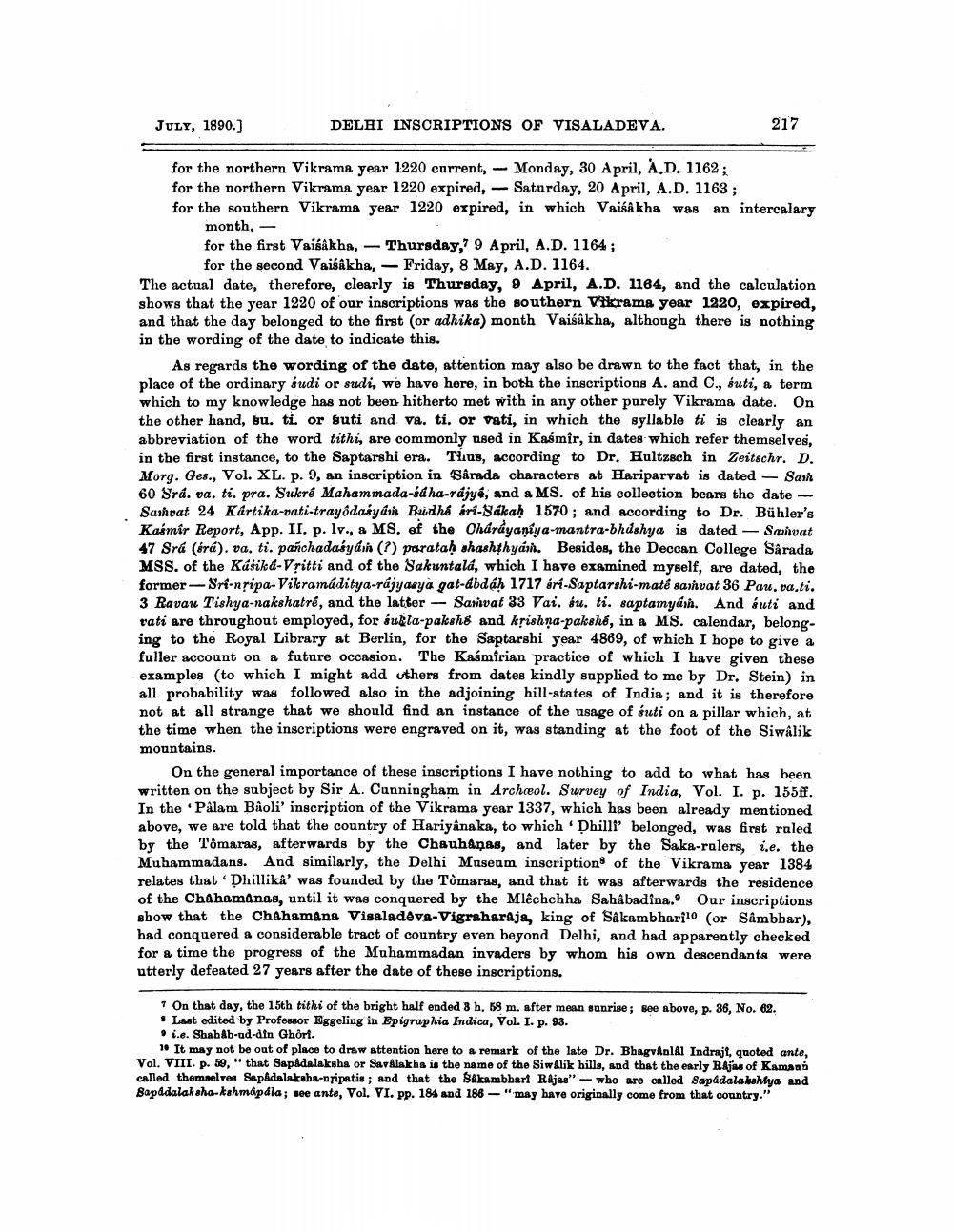________________
JULY, 1890.]
DELHI INSCRIPTIONS OF VISALADEVA.
-
Monday, 30 April, A.D. 1162;
Saturday, 20 April, A.D. 1163;
for the northern Vikrama year 1220 current, for the northern Vikrama year 1220 expired, for the southern Vikrama year 1220 expired, in which Vaisâkha was an intercalary month,
for the first Vaisakha, - Thursday, 9 April, A.D. 1164;
for the second Vaisakha, - Friday, 8 May, A.D. 1164.
The actual date, therefore, clearly is Thursday, 9 April, A.D. 1164, and the calculation shows that the year 1220 of our inscriptions was the southern Vikrama year 1220, expired, and that the day belonged to the first (or adhika) month Vaisakha, although there is nothing in the wording of the date to indicate this.
217
-
As regards the wording of the date, attention may also be drawn to the fact that, in the place of the ordinary sudi or sudi, we have here, in both the inscriptions A. and C., suti, a term which to my knowledge has not been hitherto met with in any other purely Vikrama date. On the other hand, su. ti. or suti and va. ti. or vati, in which the syllable ti is clearly an abbreviation of the word tithi, are commonly used in Kasmir, in dates which refer themselves, in the first instance, to the Saptarshi era. Thus, according to Dr. Hultzsch in Zeitschr. D. Morg. Ges., Vol. XL. p. 9, an inscription in Sârada characters at Hariparvat is dated Sam 60 Srá. va. ti. pra. Sukré Mahammada-sáha-rájyé, and a MS. of his collection bears the date - Samvat 24 Kartika-vati-trayôdasyám Budhé éri-Sákaḥ 1570; and according to Dr. Bühler's Kasmir Report, App. II. p. lv., a MS. of the Chárayaniya-mantra-bhúshya is dated Samvat 47 Srá (érá). va. ti. pañchadasyám (?) parataḥ shashthyam. Besides, the Deccan College Sârada MSS. of the Kásiká-Vritti and of the Sakuntala, which I have examined myself, are dated, the former-Sri-nripa-Vikramaditya-rajyasya gat-ábdáḥ 1717 éri-Saptarshi-maté samvat 36 Pau.va.ti. 3 Ravau Tishya-nakshatré, and the latter Samvat 33 Vai. su. ti. saptamyam. And suti and vati are throughout employed, for subla-pakshe and krishna-pakshé, in a MS. calendar, belonging to the Royal Library at Berlin, for the Saptarshi year 4869, of which I hope to give a fuller account on a future occasion. The Kasmirian practice of which I have given these examples (to which I might add others from dates kindly supplied to me by Dr. Stein) in all probability was followed also in the adjoining hill-states of India; and it is therefore not at all strange that we should find an instance of the usage of uti on a pillar which, at the time when the inscriptions were engraved on it, was standing at the foot of the Siwalik mountains.
On the general importance of these inscriptions I have nothing to add to what has been written on the subject by Sir A. Cunningham in Archaeol. Survey of India, Vol. I. p. 155ff. In the Pâlam Bâoli' inscription of the Vikrama year 1337, which has been already mentioned. above, we are told that the country of Hariyânaka, to which 'Dhilli' belonged, was first ruled by the Tômaras, afterwards by the Chauhanas, and later by the Saka-rulers, i.e. the Muhammadans. And similarly, the Delhi Museum inscription of the Vikrama year 1384 relates that Dhillikâ' was founded by the Tomaras, and that it was afterwards the residence of the Châhamânas, until it was conquered by the Mlêchchha Sahâbadina. Our inscriptions show that the Chahamana Visaladeva-Vigraharaja, king of Sakambhari10 (or Sâmbbar), had conquered a considerable tract of country even beyond Delhi, and had apparently checked for a time the progress of the Muhammadan invaders by whom his own descendants were utterly defeated 27 years after the date of these inscriptions.
7 On that day, the 15th tithi of the bright half ended 3 h. 58 m. after mean sunrise; see above, p. 36, No. 62. Last edited by Professor Eggeling in Epigraphia Indica, Vol. I. p. 93.
i.e. Shahab-ud-din Ghori.
10 It may not be out of place to draw attention here to a remark of the late Dr. Bhagvanlal Indrajt, quoted ante, Vol. VIII. p. 59," that Sapâdalaksha or Savalakha is the name of the Siwalik hills, and that the early Rajas of Kamann called themselves Sapadalaksha-nripatis; and that the S&kambhart Rajas" who are called Sapádalakshiya and Sapádalaksha-kehmopála; see ante, Vol. VI. pp. 184 and 186-"may have originally come from that country."




